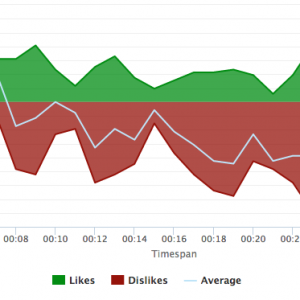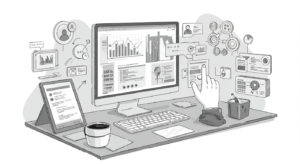Unlocking AI Consumer Insights to Improve Your Business

In today’s fast-paced and ever-evolving business landscape, it is more important than ever to stay ahead of the competition. One of the key factors that can set your business apart is the ability to understand your customers deeply and deliver a personalized experience that meets their unique needs and preferences. This is where AI-powered consumer insights and companies like Spot Trender come into play.
Understanding the Power of AI in Consumer Insights
Consumer insights have come a long way in the past few years. With the rise of big data and artificial intelligence, businesses can now gather and analyze vast amounts of data on their customer’s behavior, preferences, and opinions. This helps them gain a deeper understanding of their target audience, identify new opportunities, and optimize their offerings to cater to changing market trends and consumer demands.
The Evolution of Consumer Insights
Traditionally, consumer insights were gathered through focus groups, surveys, and other forms of market research. While these methods are still relevant today, they are often time-consuming and may not capture the full picture of consumer behavior. With the advent of AI, businesses can now tap into a wealth of data sources, such as social media, mobile, and web interactions to gain a real-time understanding of their customers.
For example, a company can use AI to analyze social media conversations about their products and services. By tracking mentions, sentiment, and engagement levels, they can gain insights into how consumers perceive their brand, what they like or dislike about their offerings, and what they expect in the future. This information can then be used to improve marketing campaigns, develop new products, and enhance customer experience.
In addition, AI can help businesses identify and segment their target audience more effectively. By analyzing data on customer demographics, behavior, and preferences, companies can create personalized marketing messages and offers that resonate with each segment. This not only improves conversion rates but also helps build long-term customer loyalty.
How AI is Transforming the Industry
AI technology has brought a new level of efficiency and accuracy to consumer insights. By employing algorithms and machine learning techniques, businesses can now leverage data to predict consumer behavior, identify patterns, and uncover insights that were previously hidden. This allows them to make informed decisions and take proactive measures to stay ahead of the competition.
For example, a company can use AI to analyze customer purchase history and identify patterns in their buying behavior. This can help them predict which products or services a customer is likely to buy in the future, and tailor their marketing messages accordingly. In addition, AI can help companies detect anomalies in customer behavior, such as sudden changes in purchase frequency or amount, which may indicate a problem or an opportunity.
Overall, AI is transforming the consumer insights industry by enabling businesses to gather and analyze data more efficiently, accurately, and comprehensively. As AI technology continues to evolve, we can expect even more innovative applications in this field, leading to better customer experiences, stronger brand loyalty, and higher profits.
Identifying Key AI Technologies for Consumer Insights
Consumer insights are critical for businesses that want to stay ahead of the competition. With the rise of artificial intelligence (AI), businesses can leverage these technologies to gain deeper insights into their customers’ preferences, behaviors, and emotions. Here are some key AI technologies that businesses can use for consumer insights:
Natural Language Processing (NLP)
NLP is a subset of AI that focuses on the interaction between computers and human language. It involves the use of algorithms to analyze and understand human language, including speech and text. By applying NLP techniques to customer feedback and social media data, businesses can gain insights into consumers’ opinions, emotions, and sentiment towards their products or services.
For example, NLP can be used to analyze customer reviews on e-commerce websites or social media platforms. By identifying the most commonly used words and phrases, businesses can gain insights into what customers like or dislike about their products or services. This information can be used to improve their offerings and tailor their marketing campaigns to meet the needs of their target audience.
Machine Learning and Predictive Analytics
Machine learning algorithms can analyze large datasets and identify patterns that can be used to predict future behavior. By applying these algorithms to consumer data, businesses can identify trends and patterns that can help them anticipate consumer needs and preferences.
For example, machine learning algorithms can be used to analyze customer purchase history and identify products or services that are frequently purchased together. This information can be used to create personalized product bundles or recommendations for customers, increasing the likelihood of a purchase.
Sentiment Analysis and Emotion Recognition
Sentiment analysis and emotion recognition involve the use of AI to analyze natural language text and voice data to understand how customers feel about products or services.
For example, sentiment analysis can be used to analyze customer feedback on social media platforms. By identifying positive or negative sentiment, businesses can understand how customers feel about their products or services and take appropriate action to improve their offerings.
Emotion recognition can be used to analyze customer voice data, such as call center recordings. By identifying the emotional state of the customer, businesses can tailor their response to meet their needs and improve customer satisfaction.
In conclusion, AI technologies such as NLP, machine learning, and sentiment analysis can provide businesses with valuable insights into their customers’ preferences, behaviors, and emotions. By leveraging these technologies, businesses can stay ahead of the competition and provide better products and services to their customers.
Leveraging AI to Enhance Customer Segmentation
One of the key benefits of AI-powered consumer insights is the ability to create highly specific customer segments. By analyzing customer data, businesses can group customers based on their demographics, buying behavior, and preferences. This helps them create hyper-personalized experiences that cater to each segment’s unique needs.
For example, a clothing retailer could use AI to analyze customer data and identify a segment of customers who frequently purchase athletic wear. With this information, the retailer could create a personalized email campaign featuring new athletic wear arrivals and promotions specifically targeted to this segment. This type of hyper-personalization can greatly improve customer engagement and loyalty.
Creating Hyper-Personalized Experiences
Hyper-personalization involves delivering tailored experiences to individual customers based on their preferences and behavior. By implementing AI-powered personalization strategies, businesses can deliver personalized recommendations, product suggestions, and marketing messages that resonate with each customer.
For example, an online bookstore could use AI to analyze a customer’s purchase history and browsing behavior to recommend books that they are likely to enjoy. This type of personalized recommendation can greatly improve the customer experience and increase the likelihood of repeat purchases.
Identifying High-Value Customer Segments
By using AI to analyze customer data, businesses can identify their most valuable customers and focus their marketing efforts on retaining them. This helps them maximize customer lifetime value and boost their bottom line.
For example, a subscription-based service could use AI to analyze customer data and identify a segment of customers who have been subscribed for a long period of time and have a high average order value. The business could then offer these customers exclusive promotions or rewards to encourage them to continue their subscription and increase their overall lifetime value.
Overall, leveraging AI to enhance customer segmentation can greatly benefit businesses by improving customer engagement, loyalty, and lifetime value. By using AI-powered personalization strategies, businesses can create tailored experiences that resonate with each customer, ultimately leading to increased revenue and growth.
Utilizing AI for Improved Product Development
Artificial Intelligence (AI) has revolutionized the way businesses operate, and product development is no exception. AI-powered consumer insights can help businesses improve their products and services by analyzing customer feedback and behavior. This helps businesses make data-driven decisions about product improvements and feature updates.
Analyzing Customer Feedback for Product Improvements
Customer feedback is a valuable source of information for businesses. By using AI to analyze customer feedback, businesses can identify areas for improvement in their offerings. This feedback can be in the form of product reviews, customer service interactions, or social media comments. AI-powered sentiment analysis can help businesses understand the emotions behind customer feedback and identify patterns in customer complaints or suggestions. With this information, businesses can make product updates that meet the needs and preferences of their customers.
For example, a company that sells skincare products may receive feedback from customers that their moisturizer is too heavy for oily skin. By analyzing this feedback, the company can develop a lighter version of the moisturizer that is better suited for customers with oily skin.
Predicting Market Trends and Consumer Preferences
Market trends and consumer preferences are constantly evolving, and businesses need to stay ahead of the curve to remain competitive. By analyzing market trends and consumer behavior data, businesses can anticipate changing consumer preferences and stay ahead of the competition. AI-powered predictive analytics can help businesses forecast demand for certain products or services and identify emerging trends.
For example, a company that sells fitness equipment may use AI to analyze data on consumer behavior, such as search queries and social media activity, to identify a growing interest in at-home workouts. The company can then develop new products or marketing campaigns that cater to this trend.
In conclusion, AI-powered consumer insights can help businesses improve their products and services by analyzing customer feedback and behavior, predicting market trends, and anticipating changing consumer preferences. By leveraging the power of AI, businesses can make data-driven decisions that lead to better products and increased customer satisfaction.
Boosting Marketing and Sales Efforts with AI Insights
AI-powered consumer insights can also be used to optimize marketing and sales efforts. By gaining a better understanding of their target audience, businesses can tailor their marketing messages and sales strategies to resonate with their customers more effectively.
One way that AI insights can enhance marketing efforts is by providing businesses with a deeper understanding of their customer’s preferences and behaviors. This can help businesses create marketing campaigns that are more targeted and relevant to their customers’ needs. For example, if a business knows that their customers are interested in sustainability, they can create marketing messages that highlight their eco-friendly practices and products.
Another way that AI insights can improve marketing campaigns is by helping businesses identify the most effective channels to reach their target audience. By analyzing customer data, businesses can determine which channels their customers are most likely to engage with, such as social media, email, or direct mail. This can help businesses allocate their marketing budget more efficiently and improve their ROI.
Optimizing Marketing Campaigns
By analyzing customer data, businesses can optimize their marketing campaigns to maximize ROI. They can identify the most effective channels and messaging that resonate with their target audience and adjust their campaigns accordingly.
AI insights can also help businesses create more personalized marketing messages. By analyzing customer data, businesses can determine which products or services are most relevant to each customer and create targeted messaging that speaks directly to their needs. This can help businesses increase customer engagement and loyalty.
Enhancing Sales Strategies with AI-Driven Data
By using AI to identify high-value customer segments and anticipate their needs, businesses can improve their sales strategies. This can involve targeting specific segments with tailored messages, optimizing sales processes, and providing personalized recommendations that meet their needs.
AI insights can also help businesses identify cross-selling and upselling opportunities. By analyzing customer data, businesses can determine which products or services are most likely to appeal to each customer and create targeted recommendations that encourage them to make additional purchases. This can help businesses increase their revenue and improve customer satisfaction.
Overall, AI-powered consumer insights can be a valuable tool for businesses looking to boost their marketing and sales efforts. By providing a deeper understanding of their customers’ preferences and behaviors, businesses can create more targeted and effective campaigns that drive engagement and sales.
Conclusion
AI-powered consumer insights offer businesses a wealth of opportunities to differentiate themselves, stay ahead of the competition, and deliver personalized experiences that meet their customers’ unique needs. By leveraging key AI technologies such as NLP and machine learning, businesses can unlock valuable insights into consumer behavior, preferences, and opinions. This allows them to tailor their offerings, marketing campaigns, and sales strategies to meet the needs of their target audience proactively.







